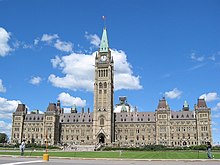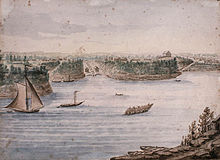Parliament Hill (Ottawa)
Parliament Hill (fr. Colline du Parlement , dt. Parliament Hill ) is a hill on the south bank of the Ottawa River in Ottawa . On top of it are the buildings of the Canadian Parliament . Originally there was a military barracks here. The conversion to the government district began in 1859 after Queen Victoria had designated Ottawa as the capital of the then province of Canada . The most striking building of the neo-Gothic ensemble from the late 19th and early 20th centuries is the Center Block with the 92 m high Peace Tower . The West Block and East Block contain mostly office space. Also of note are the Parliamentary Library and statues of various figures from Canadian history. Around three million visitors are counted every year.
terrain
The entire parliament district is 88,480 m². It is bounded to the north by the Ottawa River, to the east by the Ottawa Locks , to the south by Wellington Street and to the west by an access road to the Supreme Court . A Victorian cast iron fence runs along the south front of the site , interrupted in the middle by the Queen's Gates , the formal main entrance.
A square baroque garden is located between the three main buildings, Center Block, East Block and West Block . Important ceremonies such as the annual Canada Day festivities and the changing of the guard take place here. The gardens on the side facades of the buildings are designed in the style of the English landscape garden and are adorned with numerous statues, monuments and a pavilion on the north-west side. The remaining non-built-up area has been left in its natural state.
Parliament Hill forms the center of the government district and expansion beyond the site began in 1889 with the construction of the Langevin Block on the opposite side of Wellington Street. Since the hotel Château Laurier is located on the eastern property on the other side of the Rideau Canal , the government district expanded to the west. This is how the Confederation Building and the Justice Building were built in the 1930s . From the 1970s, the federal government began to acquire or rent additional buildings in the city center. In 1973 they expropriated the entire block between Wellington Street and Sparks Street with the intention of building a South Block . However, the project could never be realized. Instead, new office buildings were built in Gatineau .
building
The Center Block houses the House of Commons and Senate halls of Canada . On its south facade is the 92 m high Peace Tower , on the north facade facing the river the parliamentary library . The East Block and West Block contain offices for ministers and senators as well as meeting rooms and other administrative premises. All three main buildings are built in the neo-Gothic style, but contain not only borrowings from Great Britain , but also variations from France , the Netherlands and Italy .
The old Supreme Court building stood behind the West Block since 1882. It was demolished in 1955 after the court moved to a new building west of Parliament in 1945. In the 1950s and 1960s there were various considerations to replace the West Block and the Parliamentary Library with new buildings and to build a parking lot instead of the East Block, but none of these plans was ever implemented. A major renovation program began in 2002 that will cost around $ 1 billion and is expected to be completed in 2020. In particular, the masonry will be repaired, asbestos parts removed, security systems installed and visitor facilities improved. From 2012 the Center Block will be closed for five years in order to be able to carry out extensive interior renovations. The Senate and House of Commons will move to the East Block and West Block, the courtyards of which will be temporarily roofed over and set up as meeting rooms.
Statues and monuments
Most of the statues on Parliament Hill are behind the three main buildings, with one in front of the south fence. They portray the following figures in Canadian history: George-Étienne Cartier , John Macdonald , Queen Victoria , Alexander Mackenzie , Galahad , George Brown , Thomas D'Arcy McGee , Robert Baldwin , Louis-Hippolyte La Fontaine , Wilfrid Laurier , Robert Borden , William Lyon Mackenzie King , Queen Elizabeth II , John Diefenbaker , Lester Pearson and the Famous Five .
On the footpath between the Queen's Gates and the Center Block is the Centennial Flame , which was built in 1966 to mark the 100th anniversary of the Canadian Confederation. The Police and Peace Officers' Memorial commemorates those police officers who died in the course of their duties.
history
Parliament Hill is a striking , flat- topped limestone hill that has served as a landmark on the Ottawa River for centuries; first for the First Nations , later for European traders, adventurers and settlers. After Ottawa (then called Bytown) was founded, the Rideau Canal designers used the hill as a military base and named it Barrack Hill . A planned fortress was never realized and by the middle of the 19th century the hill had lost its strategic importance.
In 1858 Queen Victoria chose Bytown as the capital of the province of Canada . Because of its exposed location above the city and the river, Barrack Hill was chosen as the location of the government district. The fact that the hill was owned by the state also contributed to this decision. The Department of Public Works called on May 7, 1858 an architectural competition to erect representative buildings on Barrack Hill. 298 proposals were submitted, three of which were shortlisted. The judges could not initially agree on a winner and asked Governor General Edmund Walker Head for his opinion. Finally, the winners could be announced on August 29, 1859. Architects Thomas Fuller and Chilion Jones prevailed on the Center Block . They were based on the neo-Gothic Palace of Westminster in London and not on the recently completed neoclassical Capitol in Washington to emphasize Canada's close ties to Great Britain. Thomas Stent and Augustus Laver were successful with their designs for the East Block and the West Block.
The groundbreaking ceremony was on December 20, 1859, and the foundation stone was laid on April 16, 1860. Albert Eduard, Prince of Wales (later King Edward VII) laid the cornerstone of the Center Block on September 1, 1860 . The establishment of the Canadian government district was the largest public construction project in North America to date. The workers hit rock earlier than expected, so blasting had to be carried out. At the beginning of the year, the ministry announced that 1,424,882 had already been spent, which was more than double the originally estimated construction costs. The construction site was closed and covered in September 1861. Work could only be resumed in 1863 after a commission had investigated the causes of the cost overrun.
When the province of Canada, Nova Scotia and New Brunswick merged to form the new state of Canada in 1867, the work was still unfinished. A few years later, Manitoba , British Columbia , Prince Edward Island and the Northwest Territories also joined. This required more space for parliamentarians and the administration. Because of this, the state had to rent buildings off-site. The buildings were completed in 1876, but the site still had to be designed. On behalf of Governor General Lord Dufferin , Calvert Vaux , who had designed Central Park in New York , presented a design plan.
On February 3, 1916 at around 8:50 p.m., a fire destroyed the Center Block. The entire interior fell victim to the flames, the only exception being the library, as MC "Connie" MacCormac, a quick-reacting librarian, was able to close the massive iron doors to the rest of the building in good time. Prince Arthur, Duke of Connaught came to Ottawa and laid the original cornerstone on September 1, 1916. The reconstruction was completed by 1920. In 1927 the Peace Tower was added to commemorate the victims of the First World War. The new design by John A. Pearson and Omar Merchand is also neo-Gothic, but integrates elements of the more modern Beaux Arts architecture.
Since 1976, Parliament Hill's terraced architecture and the Parliament House complex have both enjoyed National Historic Site status .
On October 22, 2014, a soldier was shot and fatally wounded by Michael Zehaf-Bibeau in front of the National War Memorial near Parliament Hill . After the crime, the perpetrator fled to the Center Block, where he was killed by the parliamentary security chief after an exchange of fire.
Web links
- Parliament Hill website (French / English)
Individual evidence
- ↑ Parliament Hill tourist facilities overwhelmed. CTV, May 6, 2007, accessed June 19, 2009 .
- ↑ Explore the grounds. Public Works and Government Services Canada, accessed August 27, 2017 .
- ^ Building the Future. (PDF; 2.9 MB) Public Works and Government Services Canada, October 22, 1999, pp. 3–5 , accessed on June 19, 2009 (English).
- ↑ Parliament Hill blocks need $ 1B facelift. Toronto Star, July 20, 2008, accessed June 19, 2009 .
- ^ A Treasure to Explore> Parliament Hill> The History of Parliament Hill> Rehabilitation Phases. (No longer available online.) Public Works and Government Services Canada, archived from the original on July 6, 2011 ; accessed on June 19, 2009 . Info: The archive link was inserted automatically and has not yet been checked. Please check the original and archive link according to the instructions and then remove this notice.
- ^ A Treasure to Explore> Parliament Hill> The History of Parliament Hill> Pre-construction, 1826-1858. (No longer available online.) Public Works and Government Services Canada, archived from the original on July 6, 2011 ; accessed on June 19, 2009 . Info: The archive link was inserted automatically and has not yet been checked. Please check the original and archive link according to the instructions and then remove this notice.
- ↑ a b c d A Treasure to Explore> Parliament Hill> The History of Parliament Hill> Construction, 1859-1916. (No longer available online.) Public Works and Government Services Canada, archived from the original on October 6, 2011 ; accessed on June 19, 2009 . Info: The archive link was inserted automatically and has not yet been checked. Please check the original and archive link according to the instructions and then remove this notice.
- ^ Building A Seat of Government. City of Ottawa, accessed June 19, 2009 .
- ^ Directory of Designations of National Historic Significance: Ontario. Parks Canada , accessed July 10, 2010 .
- ^ Directory of Designations of National Historic Significance: Ontario. Parks Canada , accessed July 10, 2010 .
- ↑ Shots fired inside Canada parliament. BBC News , accessed October 22, 2014 .
- ^ Soldier shot at War Memorial in Ottawa. BBC News , accessed October 22, 2014 .
Coordinates: 45 ° 25 ′ 29 ″ N , 75 ° 41 ′ 57 ″ W.






